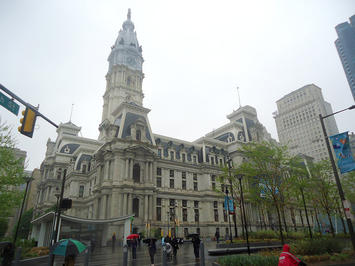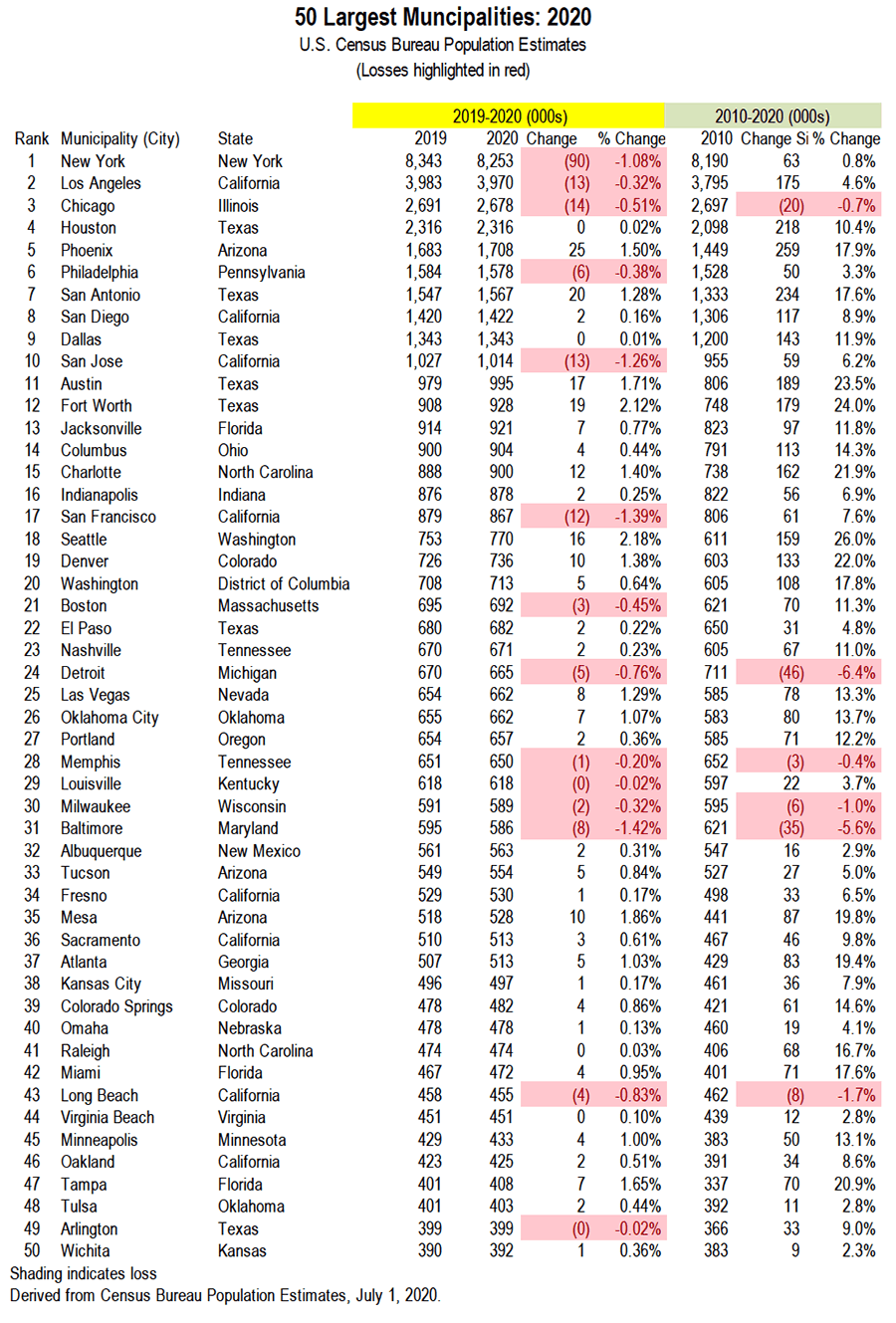
The US Census Bureau has just released its July 1, 2020 population estimates for the approximately 19,500 incorporated municipalities (principally called cities, towns, villages). This article provides information on the 50 largest municipalities in the nation (Table below).
All of the three largest municipalities, the cities of New York, Los Angeles and Chicago, lost population from 2019 to 2020.
Observations on Individual Municipalities
With 8,253,000 residents in 2020, the city of New York had its lowest annual reported population since 2010. Its 90,000 loss in 2019-2020 was the greatest sustained during the decade, while its gain over the entire decade was only 61,000. According to the Census Bureau estimates, New York’s population had peaked at 8,469,000 in 2016 and fallen by more than 200,000 over the past four years.
New York is not the only big city with a declining population. A decade ago, the California Department of Finance announced that second ranked LA city’s population had exceeded that number. But according to the Census Bureau, it never got there. In 2020 the city of Los Angeles population was 3,970,000, down 13,000 from 2019. At no point do Census Bureau estimates show that the 4,000,000 mark was ever met, despite stronger growth earlier in the decade propelled the city’s population upward by 175,000. Meanwhile, Los Angeles County, the most populous in the United States, lost 68,000 since 2010 and fell below 10 million, having lost population four years in a row.
Third ranked Chicago is the largest city to have lost population over the decade (20,000) The city lost most of those residents in the past year, with a 2019-20 loss of 14,000. Chicago lost population in each of the last six years.
Houston ranked fourth and had only a modest gain in the last year. Over the decade, the city gained 10%, to 2,316,000, but grew more slowly with the downturn in energy prices. Houston is one of five Texas municipalities among the nation’s 13 most populous. San Antonio ranked 7th and grew a strong 1.3% over the past year and 17.9% over the decade with a 2020 population of 1,567,000. The city of Dallas ranked ninth, growing little over the past year despite far more rapid growth elsewhere in the metropolitan area, and 12% over the decade to 1,343,000. Austin, will soon be the 11th city in the nation to reach a population of one million had 995,000 residents. Austin grew at a very fast 1.7% rate in the last year and added 23.5% over the past decade. Fort Worth, with 928,000 is the largest “second city” in any US metropolitan area (Dallas-Fort Worth) ranking 12th and posted a nearly 18% growth rate over the decade and 2.1% in the last year.
Phoenix passed Philadelphia during the decade, to become the fifth largest municipality. Phoenix has reached 1,708,000, growing 1.5% in the last year and nearly 18% over the decade.
Sixth ranked Philadelphia has seen its population stabilize, after earlier losses. Philadelphia’s 2020 population was 1,578,000, up 3.3% from 2010, but down 0.3% from 2019.
Eighth ranked San Diego grew about nine percent during the decade, reaching 1,422,000. However, growth stalled, at only 0.2% in the past year.
Tenth ranked San Jose fell 1.3% to 1,027,000 from 2019. Over the decade San Jose grew 6.2%.
Nearby San Francisco, ranked 17th, had 867,000 residents in 2020. This is up 7.6% over the decade, but with a loss of 1,4% over the last year.
Particularly strong population growth over the decade occurred in 14th ranked Columbus (113,000), 15th ranked Charlotte (162,000), 18th ranked Seattle (159,000), 19th ranked Denver (133,000) and 20th Washington (108,000).
Detroit continued to lose population, with 665,000 residents in 2020. This is down 5.6% in the decade and minus 0.75% in the last year.
Top and Bottom Percentage Gains
The largest percentage gain among the top 50 was in Seattle, at 26.0%, followed by Fort Worth (24,0%), Austin (23.0%), Denver (22.0%) and Charlotte (21.9%).
Despite much hopeful reporting of a renaissance, Detroit had the largest percentage loss over the decade among the top 50, at minus 6.4%. Following Detroit were Baltimore, down 5.6%, Long Beach (in the Los Angeles metropolitan area) at minus 1.7%, Milwaukee minus 1.0% while Chicago minus 1.7%.
Over the past year, the largest percentage gains have been in Seattle (2.18%), Fort Worth (2.12%), Mesa, in the Phoenix metropolitan area (1.86%), Austin (1.71%) and Tampa (1.65%).
The largest one-year percentage losses were in Baltimore (minus 1.42%), San Francisco (minus 1.39%), San Jose (minus 1.26%), New York (minus 1.08%) and Long Beach (minus 0.83%).
U.S. Population Growing Less and Dispersing
These data are estimates and are not from the 2020 Census, which has not yet published data below the state level.
These results do not reflect the total impact of the Covid pandemic, since only some three months of that period are included in these findings. Since then, there has been much evidence of population shifts from the largest and densest cities to more dispersed cities, suburbs exurbs and rural areas. For example, US Postal Service change of address data indicates the strongest out-migration in the cities of New York and San Francisco, according to The Wall Street Journal. These are the densest municipalities in the top 50.
The Covid epidemic principally affected the last quarter of the estimation periods --- one of the four 2019-2020 quarters and one of the 40 2010-2020 quarters. Over the decade, six of the top 50 municipalities lost population, while 14 lost population in 2019-2020. The deterioration in losses has multiple causes, such as the accelerating dispersion (domestic migration) from larger metropolitan areas and the generally slowing US population growth rate. At the same time, our previous research has shown that the urban cores have not even maintained their share of metropolitan populations (See: “Latest Data Shows Pre-pandemic suburban/exurban population gains”).
Click here to download a PDF document with the 2020 municipalities data
(document opens in new tab or window).

Wendell Cox is principal of Demographia, an international public policy firm located in the St. Louis metropolitan area. He is a founding senior fellow at the Urban Reform Institute, Houston, a Senior Fellow with the Frontier Centre for Public Policy in Winnipeg and a member of the Advisory Board of the Center for Demographics and Policy at Chapman University in Orange, California. He has served as a visiting professor at the Conservatoire National des Arts et Metiers in Paris. His principal interests are economics, poverty alleviation, demographics, urban policy and transport. He is co-author of the annual Demographia International Housing Affordability Survey and author of Demographia World Urban Areas.
Mayor Tom Bradley appointed him to three terms on the Los Angeles County Transportation Commission (1977-1985) and Speaker of the House Newt Gingrich appointed him to the Amtrak Reform Council, to complete the unexpired term of New Jersey Governor Christine Todd Whitman (1999-2002). He is author of War on the Dream: How Anti-Sprawl Policy Threatens the Quality of Life and Toward More Prosperous Cities: A Framing Essay on Urban Areas, Transport, Planning and the Dimensions of Sustainability.
Photo: City Hall, Philadelphia (by author).













Long Beach, CA
Pop decline over the decade is an anomaly.